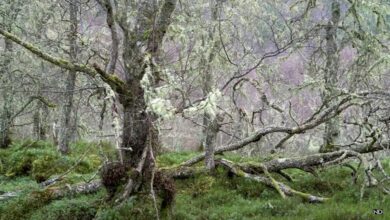How to Take Good Photos on a Cloudless Day

In a previous post, I shared my favorite way deal with an overcast sky in photography. Today, we’ll focus on the opposite: clear skies. That can also be a challenge for landscape photographers. But there are many ways to take good photos in such conditions and in this article we will explore a few of them.
For many years of my photography career, I avoided taking pictures on clear days. As a result, I missed countless photo opportunities. I recently shared some my photography year stats. That shows that excellent conditions are not the norm. Especially while traveling through Greece this past summer, I had to be content with clear skies. If I try to avoid those, I won’t take many pictures.
The following tips helped me make this successful photography trip. To provide some variance, I share a mix photo taken in greece and on other trips, like the example below.
Use reflected light
Especially in the morning and evening, the cloudless sky creates beautiful colors over the land. At those times, it acts as a giant reflector. During blue hour, your subject will have a bluish tint, and near sunrise and sunset, a combination of warm colors will prevail. Those colors can help you create different moods or emphasize certain colors in the landscape.
Take the following photo of the crater wall of Mount Ijen in Indonesia. The warm sky, which was not part of the photo, brought out the colors of the orange and yellow rocks. Soft light allowed me to capture the broken landscape’s structures without distracting the shadows.
For this photo of Kuhflucht waterfall in Germany, I got up very early to take it during blue hour. Not only does this allow for an exposure time of about 30 seconds, but the blue tones also give the photo a gloomy atmosphere. It shows that it is possible to take good pictures of waterfalls on clear days. Just try to use soft light in the late hours or early hours to avoid glare on the falls.
Use directional light
Direct light is not always bad. For some subjects, that’s what you need to get excited. Here is an example from Ta Prohm in Cambodia. This ancient hallway doesn’t look good at most times of the day. But in the early morning, with the directional light shining through the columns, the scene comes to life.
For such an image, hard shadows and contrast create depth and help draw the viewer into the frame. What this image has in common with the previous examples is that there is no sky and no light source.
Shooting Stars of the Sun
In the following example, the light source enters the frame. If you find a photogenic forest, you can use a cloudless sky. Find a layout that allows you to include the sun. Lower the lens, you can create beautiful sun stars. It works best if you position your camera so that the sun peeks out behind some trees, branches or leaves. Moving around just a few inches can make a big difference.
Next to the sun, the clear sky provides a clean canvas that accentuates the shapes of the trees.
To take such photos most effectively, use times of day when the sun is still low in the sky. The light will be softer and the contrast will not be too harsh. Around midday, it becomes much more difficult to take a good photo. It will be difficult to get the sun into the frame, and the shadows will be more chaotic and less directional.
Enlarge
A common theme in the previous tricks was excluding the sky from the image. Even in the last example with the sun, the sky is largely obscured.
A great way to remove the sky is to use a long lens. Try to find high vantage points that allow you to point the camera slightly down, as I did in the example photo. By shooting early in the morning, you can also use the shadows created by directional light. It gives such images more structure.
Find details
Even if you don’t have a long lens with you, there are ways to fill the frame with subjects that don’t need the sky. The solution is to look down at what lies beneath your feet.
When I was exploring Sarakiniko beach in Greece one morning, I couldn’t compose a shot of this moon-like landscape. The area I tried to photograph had many rock samples that needed dramatic skies to complement them. A clear sky did not work.
So I turn my attention to small details like this ice bag. Using warm, reflected light, I was able to create a minimalist photo that focuses on the nature of the rocks at Sarakiniko.
Create a clean image
A day later, I was still able to take pictures of Sarakiniko including the sky. The key to success is finding a scene without too many samples. Clear skies are not a good backdrop for chaotic scenes. But if you can compose a clear image with soft forms and shapes, a cloudless sky will provide a natural balance.
It works best if you find objects that reflect some of its colors, helping to tie everything together. Lakes, rivers and wet surfaces work well for that. But even rocks will reflect the colors of the sky to some extent.
Light ray photography
Rays of light are an elusive subject. It is difficult to find the right combination of light and fog, but the best chance to capture such conditions is on a clear morning. Cloudless skies during the night allow heat from the earth’s surface to escape into the atmosphere. It results in cooler temperatures near the ground. When they reach the dew point, fog can form.
Finding the right photo shoot location will still require preparation and searching. A forest near a lake or large grassland will give you a good chance to capture the rays. Place your subject in the direction of the rising sun. You may also want to bring a long lens as zooming in on trees surrounded by fog will help you capture this phenomenon better.
Shooting the night sky
If none of the tips above work for you, there’s one last thing you can do: Take advantage of the night sky. A cloudless night would be ideal for photographing the Milky Way or some other constellation. I dedicated a complete article to How to take great night photos. You may not get much sleep if you pursue images like the one below. But photographing the stars can be a great experience because most of the time you’ll even have the more popular photo spots to yourself.
Conclusion
As I’ve shown above, there’s no shortage of photos you can take on cloudless days and nights. Just be open-minded and don’t get too hung up on the notion that great landscape photos need dramatic clouds. To be a successful landscape photographer, you must learn how to take good pictures in all conditions. It will help you create a much more diversified portfolio that appeals to a wider audience.




